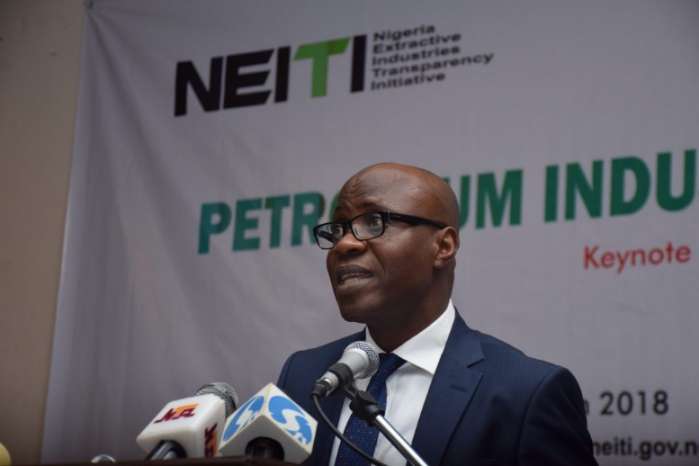36 States received N3.95 trillion in 2018 – NEITI
The Nigerian Extractive Industries Transparency Initiative (NEITI) on Wednesday disclosed that the 36 states of the federation received N3.95trillion as total revenues in 2018 but none of the states could fund their 2018 budget from their total revenue for the year.
It said the gap between total revenues and budgets ranged between N28billion in Enugu and N1.2trillion in Cross River.
NEITI said the total revenues to the states came from disbursements from the Federation Accounts and Allocation Committee (FAAC) and receipts from Internally Generated Revenues (IGR).
A breakdown of the figure shows that N2.849trillion was from FAAC allocations while N1.103trillion was internally generated revenue (IGR) by the states.
The information is contained in the latest edition of NEITI Quarterly Review titled “Insights from states’ 2018 total revenue profiles”.
The publication looked at revenues to the states against their internally generated revenues, FAAC receipts and the implications on their budgets for the year under review.
According to NEITI, “While total FAAC allocations were N2.849 trillion, total deductions were N355.761 meaning that a total of N2.494 trillion represented actual net FAAC disbursements to the states. In 2018, after deductions, the combined total (net) revenue of all states was N3.597 trillion”.
The deductions, the review explained were because of external and domestic debts including standing orders hanging on the neck of the affected states.
The analysis, conducted using data obtained from the National Bureau of Statistics, Office of the Accountant General of the Federation and the Fiscal Disbursement Unit of NEITI revealed that Lagos State had the highest total revenue of N501billion while Osun had the lowest total revenue of N33billion.
This shows that Lagos State’s revenue was higher than that of Osun State by 1,518%. Details of revenues profiles of the States with FAAC and IGR combined are produced below.
The report also carried out a comparative analysis of revenues by the six geo-political zones. The report shows that the South South zone had the highest combined revenue of N1.102trillion, followed by the South West zone with N887.8billion.
The North West and North Central had the third and fourth highest revenues of N546.5billion and N378.7billion while the North East and South East zones had N351.5billion and N340.1billion respectively.
The review highlighted that the total revenue for South South (N1.10trillion) exceeded the combined revenues for the North Central, North East and South East, which is N1.07trillion.
Similarly, the total revenue of Lagos State (N501.2 billion) exceeded total revenue of each of three zones: North Central (N378.7 billion), North East (N351.5 billion), and South East (N340.1 billion).
On internally generated revenues, the NEITI Quarterly Review noted that “Only four states had IGR above N50 billion: Delta, Lagos, Ogun and Rivers states. On the other hand, 13 states had IGR below N10 billion: Adamawa, Bauchi, Borno, Ebonyi, Ekiti, Gombe, Jigawa, Katsina, Kebbi, Nasarawa, Taraba, Yobe, and Zamfara. In addition, 11 states had IGR between N10 billion and N20 billion: Abia, Anambra, Bayelsa, Benue, Cross River, Imo, Kogi, Niger, Osun, Plateau, and Sokoto States. Eight states had IGR between N20 billion and N50 billion: Akwa Ibom, Edo, Enugu, Kaduna, Kano, Kwara, Ondo and Oyo”
The NEITI publication also revealed that most states have continued to depend on “FAAC disbursements while paying little or no attention to Internally Generated Revenues (IGR). For instance, apart from Lagos and Ogun states, FAAC disbursements exceeded IGR in 34 out of 36 states.’’
On annual budgets, the NEITI Quarterly Review disclosed that the total budgets of the 36 states in Nigeria exceeded the states’ total revenues in 2018.The least budget deficit was N28billion in Enugu while the highest budget deficit was N1.2trillion in Cross River.
“The fact that states had significantly lower total revenues than budgets can lead to two scenarios. It is either that states will not fully implement their budgets, or they will resort to borrowing to finance their budgets”, NEITI stated.
For instance, NEITI’s analyses of the debt profiles of the states showed that all the 36 states have varying degrees of debts. For most states their debts were below N50billion. Lagos State had the highest debt profile of N436.6billion while Yobe and Jigawa had the lowest debts of N36billion and N45billion respectively.
Another insight is that states with highest revenues not only had the highest budgets, but also the highest budget deficits.
The NEITI Quarterly Review observed a general trend where budgets, budget deficits and debt levels followed similar patterns with total revenue. The transparency agency noted that states and zones with higher total revenue also had higher budgets, higher budget deficits and higher debt levels.
The Review further stated that “The South South and South West zones had the largest debt levels. Considering that these two zones had the largest budgets and budget deficits, it is not surprising that states in these two zones will borrow more in order to cover their deficits.” The South East had the lowest debt level.
The NEITI Quarterly Review concluded that, “considering the high levels of budget deficits and debt, it would be advisable for states to strategise and develop innovative ways of generating revenue in order to reduce their budget deficits and deter excessive borrowing. Then, expenditure on critical developmental and investment projects can be embarked upon.”
The NEITI Quarterly Review is one of NEITI’s policy and advocacy instruments intended to provide timely information and data that could be used to support citizens’ engagement, advocacy, information sharing and enlightenment in the tracking of the use of extractive revenue for development purposes.
This is in line with the agency’s mandate of ensuring that there is transparency and accountability in the utilization of extractive revenues by government.


